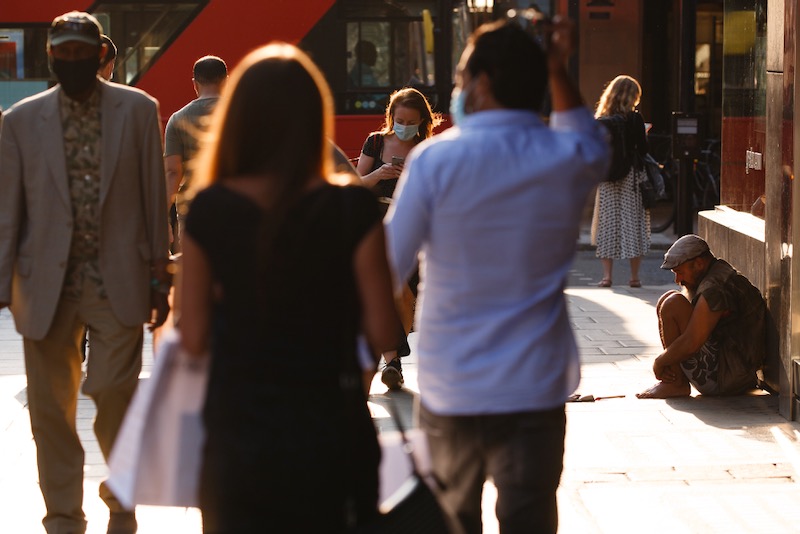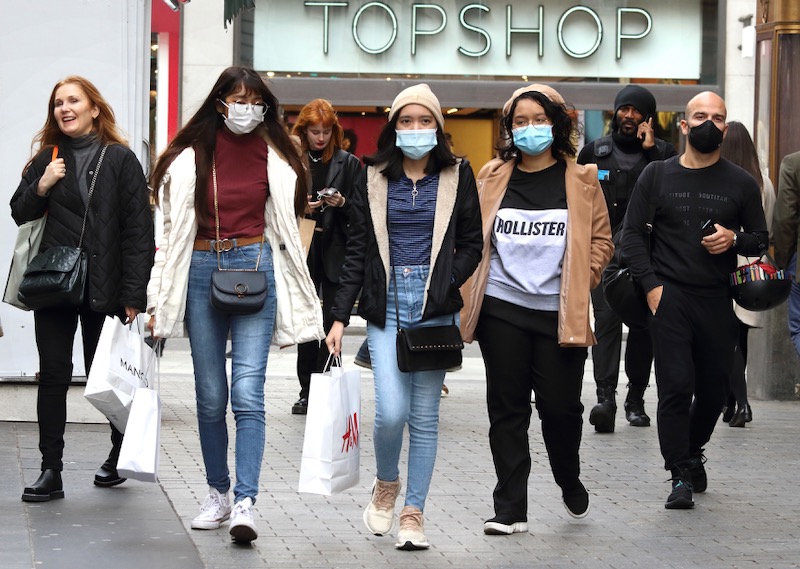I don’t like having to wear a facemask, but at the moment, there is really no choice, if you want to go shopping. My current objections are purely practical: facemasks of any kind make my glasses steam up, so that I can’t see, and on the opposite face, they make it more difficult for me to hear what is being said, as I now know that I supplement my inadequate hearing with more lipreading than I was aware of.
But the arguments in favour of wearing facemasks are very strong, so I wear one; I started with one of those pull-up scarves, but now the whole family has a collection of facemasks with earloops in a large bag by the front door, with shapes and sizes to fit everyone, and lots of different patterns and colours (and textures, for John, but I’ll come to that).
I don’t like being told what to wear, especially because I’ve been in situations where it was gender-based. I’m old enough to remember women being refused Communion because they weren’t wearing hats, and having my father drape his handkerchief over my head. My mother-in-law never returned to a church where the priest had preached against women wearing trousers (it was winter and she was pregnant). I’ve been in Orthodox churches where I was handed a piece of sacking to wear over my midi-length skirt. But at least facemasks are gender-neutral (even if there seems to be an amazing prevalence of medical conditions in noisy young men). You have to feel sorry for the French: having struggled to pass one law to outlaw face coverings, they then had to pass another one to mandate maskwearing. It can be hard to keep up.
We have certainly all become far more used to the sight of a masked face. It does unarguably cut down on communication and I can’t be the only person who finds herself using exaggerated facial expressions and pleasantries in the hope that enough friendliness will make it past the barrier to register with the other person I’m talking to….. even though it was just an off-the-cuff remark. My eyebrows get tired, and I am sad that it’s now much harder to express a smile towards a small child, so they don’t smile back as often as they used to.
Our daughter Margaret has a new worry about wearing facemasks, that we’re all going to die of cotton lung (she’s been rereading North and South recently). In the novel, the girl who dies of cotton lung has been working in a textile factory without any fan to remove the fluff from the atmosphere; her death is one of the catalysts which lead the mill-owner to install a fan system. Cotton lung is a nasty illness which is still around, though it’s now called byssinosis, caused by inhaling cotton dust (or hemp, or jute) because of inadequate safety precautions during manufacturing. It was present in parts of the US even into the twentieth century, but it’s not been a problem in Britain since Victorian times. (I checked up on all this so as to be able to reassure Margaret.) I don’t think we need to worry too much about contracting it by wearing face masks; but it led us into an interesting discussion about how different books of the Bible are fashionable at different times – fashionable or maybe comforting, because it’s very striking how many urchins and orphans in Evangelical nineteenth-century literature have Revelation at their fingertips.
Most Catholics have only a limited acquaintance with it. There’s the reading about the fearsome dragon waiting to eat the borning baby (prescribed for the feast of the Assumption), and short seasons of readings from it about the New Jerusalem in the Christmas season and after Easter of Year C, but like the book of Daniel, which has a lot in common with Revelation, we mostly skate over the weird and fantastic visions and prophecies, and don’t include them in the Sunday readings. If the Bible is a library rather than just one book, Revelation is the sci-fi and comic book section, and you can see how great an impression it would make on people who had very few other books. It’s the same with film. Revelation is the equivalent of lurid and wildly exciting stories in glorious Technicolor. My mother was a child when coloured films came in, and she never forgot the impact it had (she went to see Snow White when it first came out, and was still worried about us all being frightened of the Wicked Queen when she took us to see it maybe thirty years later). What we can see is important; faces count; visual impact can be long-lasting.
What struck me most about facemasks is how quickly people started to personalise them, or use them as a way to convey a message. When they first became desirable, and then recommended, they were almost impossible to get hold of. There were internet patterns to help you make your own, some completely half-baked, some highly ingenious (Korean ones made out of a sock). I even made some knitted ones, though of course you have to line them with tightly-woven fabric, as knitting is a mesh of holes easily big enough for aerosols and viruses to escape through; the advantage of a knitted outer is that it’s stretchy and (reasonably) comfortable, but it’s no use without a lining. Anyone with medical connections could obtain proper-looking masks through work, until the supply gave out and we were all told that we shouldn’t be looking for facemasks anyway, as face coverings were just as good, and meant that the other sort would be available for those who needed them at work. But they were all still difficult to obtain, and various canny manufacturers saw a marketing opportunity. Since then, they are everywhere (and also unfortunately, turning into a frequent element of littering in the street, and you can’t just pick them up and dump them in the nearest bin, as they could easily carry infection). There are even sites and shops which sell nothing else.
If you search for images of anything at the moment, you won’t get very far before the pictures start including whatever you are looking for turned into a facemask. If you are particularly keen on something, you can usually track down a facemask version. Every taste is catered for. As always, it’s fun to watch how the children approach it. Rachel really doesn’t like masks, because of her asthma, but we found one with dinosaurs on, which helped. I have not seen Peter since lockdown, but I’m looking forward to discovering what the cool hipster is wearing. John is still hunting for his dream facemask. He’s very worried about texture, so we have tried organic cotton and silk, but what he really wants is a purple one with tiny discreet owls, which we haven’t managed to find yet, as they have to be properly subtle; and he’s still worrying about texture (superfine cotton jersey would be best). Edmund just wants one that doesn’t get in the way too much, and prefers a plain design. Mary’s has to be made in a non-exploitative way, from eco-friendly material, and with not too mainstream or obvious a design (I’ve seen a jousting knight which might appeal, but I’ll have to check). Margaret has one with bees on, and another one with Winnie-the-Pooh illustrations (Shepard, not Disney), which she likes. And since they all have to be washed after each wearing, people can’t be too precious about them, and we have several plain ones held in common, and even disposables for train journeys. My husband has one with VW campervans on, but prefers disposables for the train. I have two that I like, one with a cherub on, made by a beloved aunt, and one with music notes, although that’s slightly disappointing because the notes are printed all different ways up and don’t actually represent a tune.
I suspect carefully-chosen facemasks might figure among the Christmas presents this year, as people ask elaborately careless questions about favourite animals and so on. I think the cute facemasks only really look good on small children, if then, and they don’t usually have to wear one. Some of the animal ones, with snouts or muzzles, are rather scary. Some facemasks come accompanied by a charitable donation, but branding can easily become too obvious. Overt messages on facemasks are like capital letters on line: they feel like shouting.
It was interesting to watch the politicians dealing with facemasks. Nicola Sturgeon’s was one of the best, neat and on-message in tartan, but I couldn’t help wondering whether it was made of wool, as tartan usually is, because then it would be difficult to wash at a hot temperature. Some people like to use national flags, some think it’s disrespectful; some masks have corporate logos, some reference a football team. I thought it was unfair for schools to insist on uniform ones (I was OK with them just setting a colour), but then some commercial facemasks can be offensive or just plain ugly, and there will always be people who want to push the boundaries. Personally I don’t like the ones with replacement faces shown on them, but some do. It all depends why you are wearing them. If being able to make a statement means that you are more likely to wear them (and so protect other people), make your statement, and keep your germs in-house.
Nowadays you can get a facecovering which expresses your personality, sends a message, indicates your corporate loyalties, makes a joke, advertises your interests, pictures your favourite filmstar, matches your school uniform…...and also protects anyone you walk past from any germs you are breathing out. Not bad for a small piece of cloth. And we are now allowed to call them facemasks, which makes all the earlier fussy distinction seem a bit silly. I did hope that the cooler weather would make them more comfortable and easier to wear, but I have to report that the clouding-up is even more of a problem, and this autumn is turning out even more misty than Keats’. Be very careful crossing roads.
Kate Keefe composes musical settings for the Mass and writes about the psalms. You can follow her on Facebook, Twitter and LinkedIn



 Loading ...
Loading ...
What do you think?
You can post as a subscriber user ...
User comments (0)